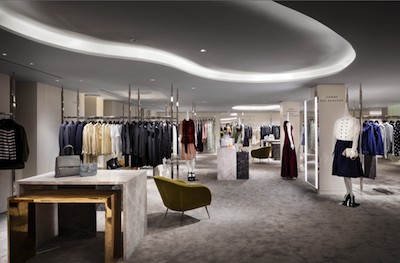 Technology is a top priority for high performing retailers
Technology is a top priority for high performing retailers
Globalization and security risks are the biggest concerns for retail executives, narrowly beating out shifting consumer tastes and technological disruption, according to a new Economist Intelligence Unit report. The report, sponsored by Demandware, found that executives are embracing a “back to basics” approach to take advantage of these changes. Although the luxury landscape will continue to change, likely at an unprecedented pace, excellent products and service are two things that will never go out of style. "To ensure success and growth moving forward, retailers need to refocus their efforts towards the customer – providing tech-twists to product excellence, seamless service and value," said Rob Garf, vice president of industry strategy and insights at Demandware. "This shift is not only a matter of technology and innovation, but also one that requires organizational change.
"Amidst this disruptive landscape, retail executives are going 'back to the basics,' while placing the customer at the center of everything they do, to distinguish themselves from the pack. In particular, high-performing retailers take globalization, evolving marketplaces, and technology head on in an effort to provide a customer-centric shopping experience.
For “Finding retail growth: A view from the corner office,” The Economist Intelligence Unit surveyed 225 C-level executives and 75 senior vice presidents, vice presidents or directors. Half were from Europe, 30 percent from North America and 20 percent Asia-Pacific. Keep expanding Across the board, 60 percent of executives are pointing to “product excellence” as a key differentiator, while 53 percent cite “seamless service,” including unified cross-channel experiences. However, many of those who were surveyed noted that changing customer behavior and the impact of technology are making it harder to stand out in crowded sectors. Despite the “seamless service” focus, however, only 14 percent of executives cited a rise in the need for omnichannel capabilities as one of the next three years’ biggest factors. Consumers’ shopping habits now move seamlessly through different channels, meaning that a unified commerce platform represents a major opportunity in today’s tech-driven world. "Millennials are completely and totally technology native, embracing it as a tool in every aspect of their lives, including while shopping," Mr. Garf said. "Technology allows them to gather information on a wide variety of products at any place and time, purchasing at the exact moment they feel inclined to do so. By enabling a consistent shopping experience across all touch points - be it via a mobile device, computer, or in-store - retailers can make themselves relevant throughout the buying process." Holt Renfrew ecommerce site
Moreover, 21 percent of executives currently see perceived value for money paid as important to their competitive differentiation, but 27 percent expect that to be a major selling point in three years. No other competitive differentiator has such a high jump, indicating an awareness of the value mindset that the consumer of the future is adopting.
The sole exception was mergers and acquisitions, which lower performers focused on at an 11 percent clip compared to 9 percent for high performers.
While around a quarter is still a small percentage and omnichannel numbers are not encouraging, retailers are confident. Seventy-six percent claim they are “very or extremely prepared” for the rise of the fast-fashion operating model across different segments, while 70 percent said the same about the rise of mass customization. On the lowest end, 59 percent and 56 percent proclaim preparation for a rise in counterfeit goods and the need for tech-savvy employees, respectively.
The report points out, however, that seven of the nine key trends it asks about are reliant on technology, yet retailers’ confidence and priorities generally push technology to the side. As a result, confidence is bordering on recklessness.
Mindset plays a large part in confronting these obstacles. Data from the report shows that those who are focused on growth rather than merely surviving tend to outperform their less ambitious counterparts.
Holt Renfrew ecommerce site
Moreover, 21 percent of executives currently see perceived value for money paid as important to their competitive differentiation, but 27 percent expect that to be a major selling point in three years. No other competitive differentiator has such a high jump, indicating an awareness of the value mindset that the consumer of the future is adopting.
The sole exception was mergers and acquisitions, which lower performers focused on at an 11 percent clip compared to 9 percent for high performers.
While around a quarter is still a small percentage and omnichannel numbers are not encouraging, retailers are confident. Seventy-six percent claim they are “very or extremely prepared” for the rise of the fast-fashion operating model across different segments, while 70 percent said the same about the rise of mass customization. On the lowest end, 59 percent and 56 percent proclaim preparation for a rise in counterfeit goods and the need for tech-savvy employees, respectively.
The report points out, however, that seven of the nine key trends it asks about are reliant on technology, yet retailers’ confidence and priorities generally push technology to the side. As a result, confidence is bordering on recklessness.
Mindset plays a large part in confronting these obstacles. Data from the report shows that those who are focused on growth rather than merely surviving tend to outperform their less ambitious counterparts.
 Barneys' new Chelsea location has implemented customer identification via iBeacons
For high performers, globalization is an opportunity rather than a threat. They are focusing on geographic expansion, strategic partnerships and new stores and formats, and 82 percent intend to increase tech spending compared to just 56 percent of low performers.
High performers are particularly focused on geographic expansion, technology and online marketplaces.
On the horizons
Other reports have shown that unified commerce and omnichannel developments are a high priority, but full implementation is still years away.
While 85 percent of retailers consider unified commerce a top priority, most are not making enough of an effort in upgrading their infrastructure to achieve a fully seamless shopping experience.
According to a new report from Boston Retail Partners, retailers have attempted to reformat their outdated systems to accommodate cross-channel capabilities, leaving many with “faux omnichannel.” As the consumer comes to expect a uniform service across channels, retailers are at risk of losing clientele if they do not implement a more holistic system (see story).
To succeed moving forward, brands must be attuned to consumer travel patterns, particularly to those of the growing Chinese consumer class. For those consumers, lower prices in other countries lead many to plan vacations with the intent of buying luxury items.
Chinese residents will make 90 million outbound trips in 2020, with that number increasing by an additional 36 million over the following decade, according to a report by Euromonitor.
As reported in “How to Target Chinese Shoppers Abroad,” outbound trips have increased on average by an impressive 13 percent since 2000, helping China overtake Japan as the second largest consumer market in 2011. With the significance and size of the Chinese tourist market only projected to swell, brands will need to develop a more nuanced understanding of the market in order to reach consumers (see story).
"While growth is no longer driven solely by opening new store locations, retailers shouldn’t abandon bricks-and-mortar," Mr. Garf said. "Consumers still want to get up close and personal with the products and brands they’ve researched online and experienced via social media.
"Technology, however, enables retailers to connect their online and in-store experiences to create and enhance the unified shopping experience. Retailers should infuse it into every area of their operations," he said. "Don’t just invest in technology though – ensure it’s operationalized via training and incentives! The more information that can be analyzed and processed, the more personalized and tailored a retailer can make their shopping experience whether that’s in-store or online."
Barneys' new Chelsea location has implemented customer identification via iBeacons
For high performers, globalization is an opportunity rather than a threat. They are focusing on geographic expansion, strategic partnerships and new stores and formats, and 82 percent intend to increase tech spending compared to just 56 percent of low performers.
High performers are particularly focused on geographic expansion, technology and online marketplaces.
On the horizons
Other reports have shown that unified commerce and omnichannel developments are a high priority, but full implementation is still years away.
While 85 percent of retailers consider unified commerce a top priority, most are not making enough of an effort in upgrading their infrastructure to achieve a fully seamless shopping experience.
According to a new report from Boston Retail Partners, retailers have attempted to reformat their outdated systems to accommodate cross-channel capabilities, leaving many with “faux omnichannel.” As the consumer comes to expect a uniform service across channels, retailers are at risk of losing clientele if they do not implement a more holistic system (see story).
To succeed moving forward, brands must be attuned to consumer travel patterns, particularly to those of the growing Chinese consumer class. For those consumers, lower prices in other countries lead many to plan vacations with the intent of buying luxury items.
Chinese residents will make 90 million outbound trips in 2020, with that number increasing by an additional 36 million over the following decade, according to a report by Euromonitor.
As reported in “How to Target Chinese Shoppers Abroad,” outbound trips have increased on average by an impressive 13 percent since 2000, helping China overtake Japan as the second largest consumer market in 2011. With the significance and size of the Chinese tourist market only projected to swell, brands will need to develop a more nuanced understanding of the market in order to reach consumers (see story).
"While growth is no longer driven solely by opening new store locations, retailers shouldn’t abandon bricks-and-mortar," Mr. Garf said. "Consumers still want to get up close and personal with the products and brands they’ve researched online and experienced via social media.
"Technology, however, enables retailers to connect their online and in-store experiences to create and enhance the unified shopping experience. Retailers should infuse it into every area of their operations," he said. "Don’t just invest in technology though – ensure it’s operationalized via training and incentives! The more information that can be analyzed and processed, the more personalized and tailored a retailer can make their shopping experience whether that’s in-store or online." 